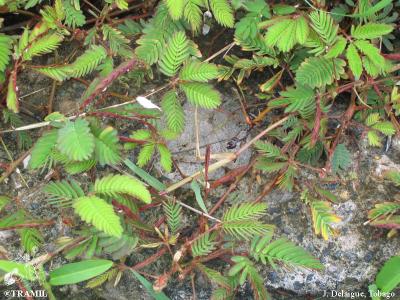feuille fraîche et racine, infusion ou décoction, voie orale1
Selon l'information disponible :
L'usage en cas de dysménorrhée est classé REC basé sur l'emploi significatif traditionnel documenté dans les enquêtes TRAMIL et l'information scientifique publiée.
Etant donné le risque que la dysménorrhée obéisse à des problèmes de santé plus complexes (endométriose, fibrome, maladie inflammatoire pelvienne, infection transmise sexuellement, grossesse extra-utérine, tumeur, etc), l'évaluation médicale initiale est recommandée. L'utilisation de cette ressource doit être considérée comme un complément à un traitement médical, sauf contre-indication.
Si l'état du patient se détériore ou si les symptômes persistent au-delà de 5 jours, il faut consulter un médecin.
Ne pas utiliser chez la femme enceinte ou allaitante, ni chez les enfants en dessous de 12 ans.
Contre les “menstrual cramps” (crampes menstruelles, dysménorrhée) :
Préparer une décoction ou infusion avec 5 grammes de feuilles et de racines dans 4 tasses (1 litre) d'eau. En cas de décoction bouillir 10 minutes dans un récipient couvert. Pour l’infusion, ajouter de l'eau bouillante à 15 grammes de feuilles et de racines et couvrir. Laissez refroidir, filtrer et boire 1 tasse 3 fois par jour pendant 3 à 5 jours maximum.
Toute préparation médicinale doit être conservée au froid et utilisée dans les 24 heures.
1 DELAIGUE J, 2005
TRAMIL survey. UAG & PRDI, Tobago House of Assembly, Scarborough, Tobago.
2 APPLEWHITE P, 1973
Serotonin and norepinephrine in plant tissues. Phytochemistry 12(1):191-192.
3 GUPTA MP, Arias TD, Correa M, Lamba SS, 1979
Ethnopharmacognostic observations on Panamanian medicinal plants. Part I. Q J Crude Drug Res 17(3/4):115-130.
4 TSURUMI S, ASAHI Y, 1985
Identification of jasmonic acid in Mimosa pudica and its inhibitory effect on auxin- & light-induced opening of the pulvinules. Physiol Plant 64(2):207-211.
5 ATAL CK, SRIVASTAVA JB. WALI BK, CHAKRAVARTY RB, DHAWAN BN, RASTOGI RP, 1978
Screening of Indian plants for biological activity. Part. VIII. Indian J Exp Biol 16:330-349.
6 SEAFORTH C, ADAMS C, SYLVESTER Y, 1982
A guide to the medicinal plants of Trinidad and Tobago. CSC (82) NP7 London, England: Commonwealth Secretariat.
7 TANGENDJAJA B, WILLS R, 1980
Analysis of mimosine & 3-hydroxy-4 (1H)- pyridone by high-performance liquid chromatography. J Chromatogr 202(2):317-318.
8 NGO BUM E, DAWACK DL, SCHMUTZ M, RAKOTONIRINA A, RAKOTONIRINA SV, PORTET C, JEKER A, OLPE HR, HERRLING P, 2004
Anticonvulsant activity of Mimosa pudica decoction. Fitoterapia 75(3-4):309-314.
9 GANGULY M, DEVI, N MAHANTA R, BORTHAKUR MK, 2007
Effect of Mimosa pudica root extract on vaginal estrous and serum hormones for screening of antifertility activity in albino mice. Contraception 76(6):482-485.
10 CHANDRASHEKAR DK, MANTHALE DM, 2012
Invention of analgesic and anti-inflammatory activity of ethanolic extract of Mimosa Pudica Linn leaves. J of Biomedical and Pharmaceutical 1(1):36-38.
11 BHAKUNI S, DHAR ML, DHAR MM, DHAWAN BN, MEHROTRA BN, 1969
Screening of Indian plants for biological activity. Part II. Indian J Exp Biol 7:250-262.
12 MOLINA M, CONTRERAS CM, TELLEZ-ALCANTARA P, 1999
Mimosa pudica may possess antidepressant actions in the rat. Phytomedicine 6(5):319-323.
13 VIJAYASARATHY V, SHARMA L, PRAKASH A, 1981
Indigenous drug treatment for hemmorhoids. Probe 20(4):285-287.
14 AGRAWAL RC, KAPADIA LA, 1982
Treatment of piles with indigenous drugs-pilex tablets and ointment along with styplon. Probe 21(3):201-204.
15 VAIDYA GH, SHETH UK, 1986
Mimosa pudica (Linn.) its medicinal value and pilot clinical use in patients with menorrhagia. Anc Sci Life 5(3):156-160.
16 NORTON S, 1979
Anti-fertility activity of leaves of Mimosa pudica in early pregnancy of albino rats. Indian J Zool 6(2):89-93.


